Buying a TV in summer 2022 is as confusing as ever, so let’s make it simple. Below you’ll find a list of the best TVs we’ve reviewed across a range of sizes and prices. At CNET we concentrate on reviewing TVs that have the picture quality and features you need without wasting money on stuff you don’t. Because there’s so much variety in the TV market today, our top picks run high-end OLEDs to budget LCDs and everything in between.
One important tip: Consider a 2021 model first. New 2022 TVs are on store shelves and online retailers for summer, promising enhancements like better picture quality, more features and future-proof HDMI connections. But last year’s TVs are still available, too, and for the most part they’re just as good and much better deals. We compared the LG C1 and LG C2 OLED TVs, for example, and the new C2 didn’t look much better than the C1 from 2021, which costs hundreds less. The 2021 models we recommend below include a “2022 Outlook” section to give you a sense of what you’re missing (or not).
TVs come with a range of smart TV streaming systems — from Roku to Google TV to Samsung — and (unfortunately) a lot of tech jargon. One quick takeaway? LCD TVs with local dimming, mini-LED or QLED screen technology are usually less expensive than OLED televisions, and still perform well while supporting 4K resolution with HDR. Now, on to our picks.

 \n ","topic":"","ttag":"","searchDim":"article-body|listicle|image","variant":"article-body|listicle|image","viewguid":"","event":"listicle|image|1","correlationId":"","_destCat":"https:\/\/www.amazon.com\/TCL-Dolby-Vision-QLED-Smart\/dp\/B0885N17CC\/","productName":"TCL 65R635 (2020 Roku TV)","formatType":"IMAGE","location":"LIST","position":1,"sku":"65R635","dwLinkTag":"article-body|listicle|image","selector":"#article-body #listicle-b23c1112-82e2-4cc1-81ef-2028825b2e23 .itemImage"}}” rel=”noopener nofollow” target=”_blank”>
\n ","topic":"","ttag":"","searchDim":"article-body|listicle|image","variant":"article-body|listicle|image","viewguid":"","event":"listicle|image|1","correlationId":"","_destCat":"https:\/\/www.amazon.com\/TCL-Dolby-Vision-QLED-Smart\/dp\/B0885N17CC\/","productName":"TCL 65R635 (2020 Roku TV)","formatType":"IMAGE","location":"LIST","position":1,"sku":"65R635","dwLinkTag":"article-body|listicle|image","selector":"#article-body #listicle-b23c1112-82e2-4cc1-81ef-2028825b2e23 .itemImage"}}” rel=”noopener nofollow” target=”_blank”>
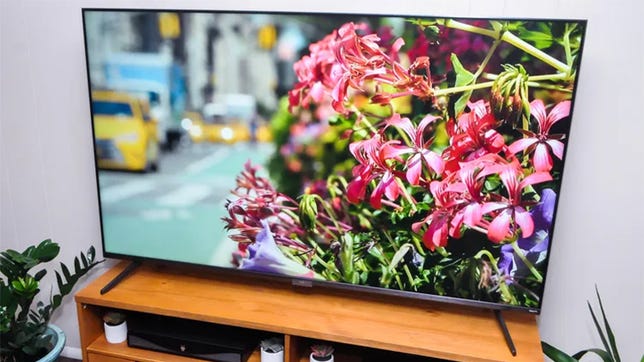

David Katzmaier/CNET
No TV we’ve ever tested offers this much picture quality for as little cash. The TCL 6-Series Dolby Vision HDR TV has an excellent image thanks to mini-LED tech and well-implemented full-array local dimming that helps it run circles around just about any other TV at this price. It’s also a solid choice for gamers, with a THX mode that combines low input lag and high contrast. As if that’s not enough, the Roku TV operating system is our hands-down favorite.
This TV first came out in 2020 but is still a current model and remains our top choice. TCL also sells an 8K version of the 6-Series, but we don’t think it’s worth the extra money, as well as a Google-powered version we have yet to review (although according to TCL its image quality is the same as this Roku version).
Sizes: 55-, 65-, 75-, 85-inch. (The prices shown below are for the 65-inch size.)
2022 outlook: TCL has yet to announce a successor for this TV but we expect the company to do so later this summer.

 \n ","topic":"","ttag":"","searchDim":"article-body|listicle|image","variant":"article-body|listicle|image","viewguid":"","event":"listicle|image|2","correlationId":"","_destCat":"https:\/\/www.amazon.com\/LG-OLED65C1PUB-Alexa-Built-Smart\/dp\/B08WG4HKKY\/","productName":"LG OLED65C1PUB","formatType":"IMAGE","location":"LIST","position":2,"sku":"OLED65C1PUB","dwLinkTag":"article-body|listicle|image","selector":"#article-body #listicle-5d709ca3-685a-43b2-81ad-ad9775171633 .itemImage"}}” rel=”noopener nofollow” target=”_blank”>
\n ","topic":"","ttag":"","searchDim":"article-body|listicle|image","variant":"article-body|listicle|image","viewguid":"","event":"listicle|image|2","correlationId":"","_destCat":"https:\/\/www.amazon.com\/LG-OLED65C1PUB-Alexa-Built-Smart\/dp\/B08WG4HKKY\/","productName":"LG OLED65C1PUB","formatType":"IMAGE","location":"LIST","position":2,"sku":"OLED65C1PUB","dwLinkTag":"article-body|listicle|image","selector":"#article-body #listicle-5d709ca3-685a-43b2-81ad-ad9775171633 .itemImage"}}” rel=”noopener nofollow” target=”_blank”>
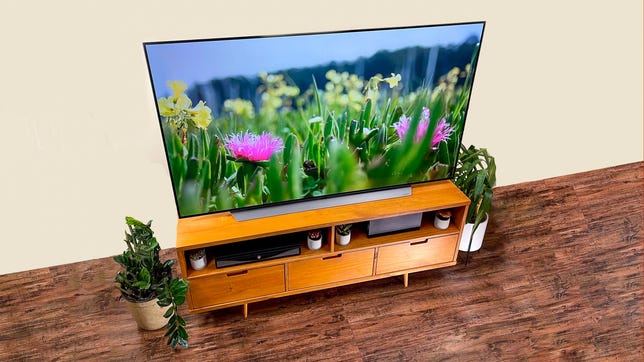

David Katzmaier/CNET
With picture quality as good as any TV we’ve ever tested and a price that’s not too crazy, the LG C1 OLED TV is still our go-to pick for people who prioritize picture and are willing to pay for it. It beats any non-OLED TV on this list, including the Samsung QN90A below, with its perfect black levels, unbeatable contrast and superb off-angle viewing. It also has the best gaming features, making it the perfect companion to an Xbox Series X or S, PlayStation 5 or both. The C1 comes in a wide variety of sizes as well, although the bigger models are really expensive.
We also reviewed the successor to the C1, the LG C2, and the two have essentially identical picture quality. The newer version brings a couple of minor improvements, including lighter weight and a 42-inch size. Since the 2021 C1 currently remains on sale for hundreds less than the 2022 C2, we recommend getting the C1 instead.
Sizes: 48-, 55-, 65-, 77-, 83-inch. (The prices shown below are for the 65-inch size.)

 \n ","topic":"","ttag":"","searchDim":"article-body|listicle|image","variant":"article-body|listicle|image","viewguid":"","event":"listicle|image|3","correlationId":"","_destCat":"https:\/\/www.target.com\/p\/tcl-43-34-class-4-series-4k-uhd-hdr-smart-roku-tv-8211-43s435\/-\/A-52177069#lnk=sametab","productName":"TCL 65S425 (Roku TV)","formatType":"IMAGE","location":"LIST","position":3,"sku":"65S425","dwLinkTag":"article-body|listicle|image","selector":"#article-body #listicle-b70c1189-8bdf-4081-9437-d2363e62555e .itemImage"}}” rel=”noopener nofollow” target=”_blank”>
\n ","topic":"","ttag":"","searchDim":"article-body|listicle|image","variant":"article-body|listicle|image","viewguid":"","event":"listicle|image|3","correlationId":"","_destCat":"https:\/\/www.target.com\/p\/tcl-43-34-class-4-series-4k-uhd-hdr-smart-roku-tv-8211-43s435\/-\/A-52177069#lnk=sametab","productName":"TCL 65S425 (Roku TV)","formatType":"IMAGE","location":"LIST","position":3,"sku":"65S425","dwLinkTag":"article-body|listicle|image","selector":"#article-body #listicle-b70c1189-8bdf-4081-9437-d2363e62555e .itemImage"}}” rel=”noopener nofollow” target=”_blank”>
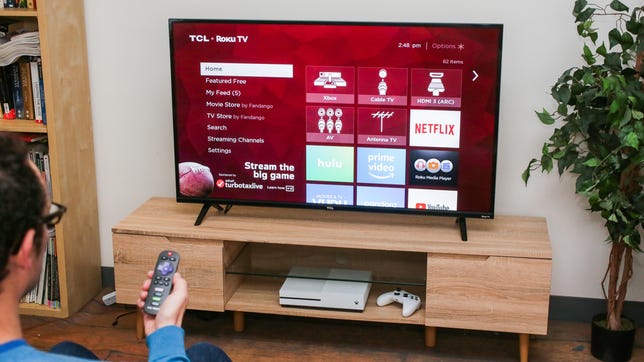

Sarah Tew/CNET
Roku is our favorite platform for live TV streaming services like Netflix, Hulu and Amazon Prime Video, and it’s even better baked into the TV. This TCL 4-Series can’t beat the models above on image quality — its 4K resolution and HDR performance don’t do much to help the picture — but it’s perfectly fine for most people, especially at this price.
Note that TCL also makes a Google TV and an Android TV version of the 4-Series. We haven’t reviewed them, but we expect similar picture quality to the Roku version.
Sizes: 43-, 50-, 55-, 65-, 75-, 85-inch. (The prices shown below are for the 50-inch size.)
2022 outlook: TCL has yet to announce a successor for this TV but we expect the company to do so later this summer.

 \n ","topic":"TVs","ttag":"other","searchDim":"article-body|listicle|image","variant":"article-body|listicle|image","viewguid":"","event":"listicle|image|4","correlationId":"","assettitle":"","campaign":"other","cval":35,"leadCpc":0.35,"leadProdPrice":549.99,"manufacturer":"Vizio","productName":"Vizio M55Q7-J01 M-Series Quantum","seriesGuid":"ed9156cd-cbc4-4a61-9642-c0995ea61d11","sku":"M55Q7-J01","reviewId":"fb539115-8091-439d-8681-5e2e6876779b","formatType":"IMAGE","location":"LIST","position":4,"dwLinkTag":"article-body|listicle|image","selector":"#article-body #listicle-ad2f6508-4b76-4256-a954-19853d7171c1 .itemImage"}}” rel=”noopener nofollow” target=”_blank”>
\n ","topic":"TVs","ttag":"other","searchDim":"article-body|listicle|image","variant":"article-body|listicle|image","viewguid":"","event":"listicle|image|4","correlationId":"","assettitle":"","campaign":"other","cval":35,"leadCpc":0.35,"leadProdPrice":549.99,"manufacturer":"Vizio","productName":"Vizio M55Q7-J01 M-Series Quantum","seriesGuid":"ed9156cd-cbc4-4a61-9642-c0995ea61d11","sku":"M55Q7-J01","reviewId":"fb539115-8091-439d-8681-5e2e6876779b","formatType":"IMAGE","location":"LIST","position":4,"dwLinkTag":"article-body|listicle|image","selector":"#article-body #listicle-ad2f6508-4b76-4256-a954-19853d7171c1 .itemImage"}}” rel=”noopener nofollow” target=”_blank”>


David Katzmaier/CNET
The Vizio MQ7 is one of the least expensive TVs to feature full-array local dimming, which lets it reproduce TV shows, movies and games with enough contrast and pop to do HDR justice. It’s a 60Hz model, not 120Hz, but it still handles variable refresh rate games for extra smoothness. If you can’t save up for the TCL 6-series but want a better picture than the 4-Series, the Vizio MQ7 is an excellent happy medium.
Sizes: 50-, 55-, 58- 65-, 70-, 75-inch. (The prices shown below are for the 55-inch size.)
2022 outlook: The 2022 version of this TV is called the MQX series. We haven’t reviewed it yet, but since it has better specifications, including enhancements like 120Hz and higher brightness, we expect it to have better picture quality. It’s also significantly more expensive and comes in only three sizes (50-, 65- and 75-inch). Vizio also announced a step-down MQ6 series with more sizes, but it lacks local dimming so we don’t expect it to perform as well as either one.

 \n ","topic":"","ttag":"","searchDim":"article-body|listicle|image","variant":"article-body|listicle|image","viewguid":"","event":"listicle|image|5","correlationId":"","_destCat":"https:\/\/www.amazon.com\/VIZIO-55-Inch-AirPlay-Chromecast-V555-J01\/dp\/B092Q527H1","productName":"Vizio V555-J","formatType":"IMAGE","location":"LIST","position":5,"sku":"V555-J01","dwLinkTag":"article-body|listicle|image","selector":"#article-body #listicle-3e9c469b-44a4-45fb-b077-22c6c1e18ca6 .itemImage"}}” rel=”noopener nofollow” target=”_blank”>
\n ","topic":"","ttag":"","searchDim":"article-body|listicle|image","variant":"article-body|listicle|image","viewguid":"","event":"listicle|image|5","correlationId":"","_destCat":"https:\/\/www.amazon.com\/VIZIO-55-Inch-AirPlay-Chromecast-V555-J01\/dp\/B092Q527H1","productName":"Vizio V555-J","formatType":"IMAGE","location":"LIST","position":5,"sku":"V555-J01","dwLinkTag":"article-body|listicle|image","selector":"#article-body #listicle-3e9c469b-44a4-45fb-b077-22c6c1e18ca6 .itemImage"}}” rel=”noopener nofollow” target=”_blank”>
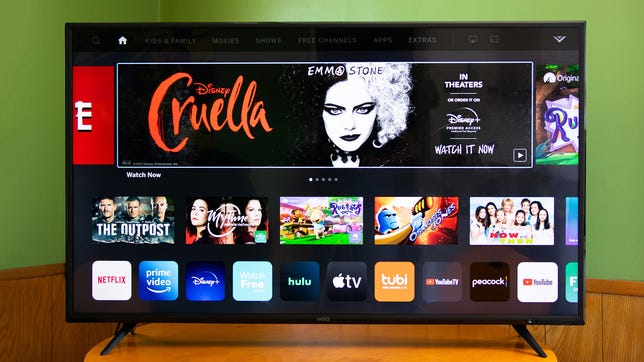

Geoffrey Morrison/CNET
Vizio’s V-Series is our favorite budget alternative to the TCL 4-Series Roku TV. We liked Roku’s smart TV system better (sound familiar?), but the V-Series has some advantages, including a better remote with voice and more advanced picture settings. Picture quality between the two was basically the same, so if you don’t have a preference, it makes sense to get the cheapest one.
Sizes: 43-, 50-, 55-, 58- 65-, 75-inch. (The prices shown below are for the 55-inch size.)
2022 outlook: The 2022 version of the V-Series has very similar specifications and pricing as the 2021 series. We haven’t reviewed it yet but we expect the two to perform about the same.

 \n ","topic":"","ttag":"","searchDim":"article-body|listicle|image","variant":"article-body|listicle|image","viewguid":"","event":"listicle|image|6","correlationId":"","_destCat":"https:\/\/www.amazon.com\/LG-65-Inch-Refresh-AI-Powered-OLED65C2PUA\/dp\/B09RMRNSBF\/","productName":"LG OLED65C2PUA","formatType":"IMAGE","location":"LIST","position":6,"sku":"OLED65C2PUA","dwLinkTag":"article-body|listicle|image","selector":"#article-body #listicle-c088ac73-7ac3-4dda-8a3a-8f42dc41fb45 .itemImage"}}” rel=”noopener nofollow” target=”_blank”>
\n ","topic":"","ttag":"","searchDim":"article-body|listicle|image","variant":"article-body|listicle|image","viewguid":"","event":"listicle|image|6","correlationId":"","_destCat":"https:\/\/www.amazon.com\/LG-65-Inch-Refresh-AI-Powered-OLED65C2PUA\/dp\/B09RMRNSBF\/","productName":"LG OLED65C2PUA","formatType":"IMAGE","location":"LIST","position":6,"sku":"OLED65C2PUA","dwLinkTag":"article-body|listicle|image","selector":"#article-body #listicle-c088ac73-7ac3-4dda-8a3a-8f42dc41fb45 .itemImage"}}” rel=”noopener nofollow” target=”_blank”>
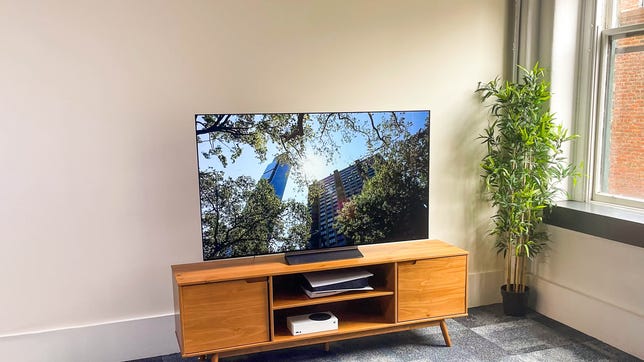

David Katzmaier/CNET
The C2 is the first 2022 TV we’ve reviewed and it’s superb, but right now the 2021 model is a better deal. We compared the C2 directly to last year’s C1, side-by-side. In terms of picture quality, the two were basically identical, despite the fact that LG touts the new “Evo” panel on the C2. Real improvements include carbon-fiber construction for up to 47% lighter weight — the 65-inch version we reviewed weighs just 37 pounds with its stand, compared to 72 pounds for the 65-inch C1 — as well as some additional tweaks to game mode and a new “always ready” feature. Those enhancements aren’t worth the price difference, so our advice is to buy a C1 now or wait until later this year, when the C1 sells out and the C2 gets a price cut.
The C2 is also available in a 42-inch size, while the smallest C1 is a 48-inch model.
Sizes: 42-, 48-, 55-, 65-, 77-, 83-inch. (The prices shown below are for the 65-inch size.)

 \n ","topic":"TVs","ttag":"direct","searchDim":"article-body|listicle|image","variant":"article-body|listicle|image","viewguid":"","event":"listicle|image|7","correlationId":"","assettitle":"","campaign":"direct","cval":50,"leadCpc":0.5,"leadProdPrice":2099.99,"manufacturer":"Samsung","productName":"Samsung QN65QN90B","seriesGuid":"f0d8e05e-3903-47c5-bedb-8df706f6dfeb","sku":"QN65QN90BAFXZA","reviewId":"","formatType":"IMAGE","location":"LIST","position":7,"dwLinkTag":"article-body|listicle|image","selector":"#article-body #listicle-f2b17bfa-163d-493b-bf15-93b7b65f748f .itemImage"}}” rel=”noopener nofollow” target=”_blank”>
\n ","topic":"TVs","ttag":"direct","searchDim":"article-body|listicle|image","variant":"article-body|listicle|image","viewguid":"","event":"listicle|image|7","correlationId":"","assettitle":"","campaign":"direct","cval":50,"leadCpc":0.5,"leadProdPrice":2099.99,"manufacturer":"Samsung","productName":"Samsung QN65QN90B","seriesGuid":"f0d8e05e-3903-47c5-bedb-8df706f6dfeb","sku":"QN65QN90BAFXZA","reviewId":"","formatType":"IMAGE","location":"LIST","position":7,"dwLinkTag":"article-body|listicle|image","selector":"#article-body #listicle-f2b17bfa-163d-493b-bf15-93b7b65f748f .itemImage"}}” rel=”noopener nofollow” target=”_blank”>
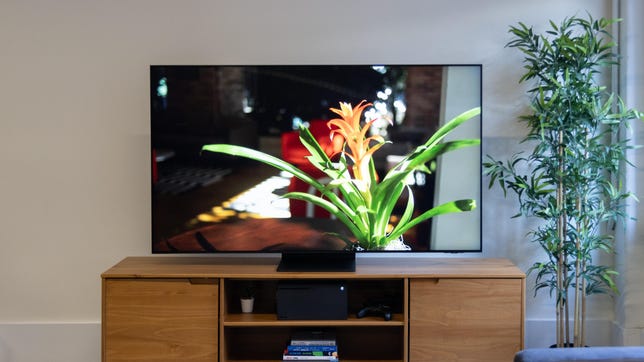

Bobby Oliver/CNET
Looking for a high-end TV with spectacular image quality, but don’t want an OLED? The Samsung QN90B is your best bet. This TV uses QLED TV tech augmented by mini-LED for a brighter image than any OLED TV. The spectacular contrast of OLED still won out in our side-by-side tests, but the QN90B QLED screen comes closer than ever.
In summer 2022 the older version of this TV, the QN90A, remains on sale for hundreds less. It’s also an excellent performer but it’s slightly dimmer than the QN90B and doesn’t do quite as good a job reducing blooming. It also lacks some of the 2022 model’s features, including the new game hub with cloud gaming.
Sizes: 43-, 50-, 55-, 65-, 75-, 85-inch. (The prices shown below are for the 65-inch size.)

 \n ","topic":"","ttag":"","searchDim":"article-body|listicle|image","variant":"article-body|listicle|image","viewguid":"","event":"listicle|image|8","correlationId":"","_destCat":"https:\/\/www.amazon.com\/Sony-X90J-Inch-Compatibility-XR55X90J\/dp\/B08TKTX6HM","productName":"Sony XR-65X90J","formatType":"IMAGE","location":"LIST","position":8,"sku":"XR-65X90J","dwLinkTag":"article-body|listicle|image","selector":"#article-body #listicle-4c39947c-d0a1-483b-8fa0-0346d456aa10 .itemImage"}}” rel=”noopener nofollow” target=”_blank”>
\n ","topic":"","ttag":"","searchDim":"article-body|listicle|image","variant":"article-body|listicle|image","viewguid":"","event":"listicle|image|8","correlationId":"","_destCat":"https:\/\/www.amazon.com\/Sony-X90J-Inch-Compatibility-XR55X90J\/dp\/B08TKTX6HM","productName":"Sony XR-65X90J","formatType":"IMAGE","location":"LIST","position":8,"sku":"XR-65X90J","dwLinkTag":"article-body|listicle|image","selector":"#article-body #listicle-4c39947c-d0a1-483b-8fa0-0346d456aa10 .itemImage"}}” rel=”noopener nofollow” target=”_blank”>
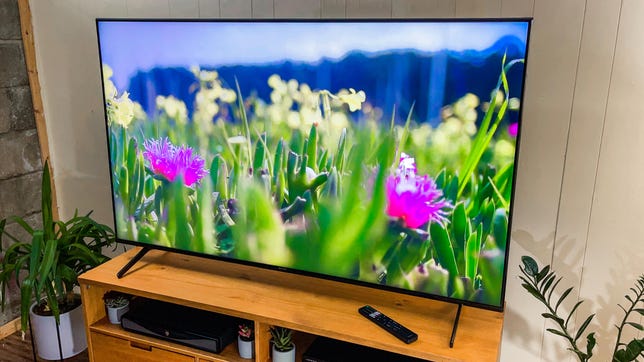

David Katzmaier/CNET
With excellent picture quality, anchored by full-array local dimming and plenty of brightness to make HDR content shine, the X90J is Sony’s answer to the TCL 6-Series and step-up Vizio models. This LED TV’s sleek looks and the Google TV operating system score additional points, as does its next-gen console support — including variable refresh rate (VRR), enabled by a software update in March 2022 — and built-in NextGen TV tuner. This Sony TV is perfect for PS5 gaming and works with Alexa & Google Assistant. If you want an “S” brand, this is one of the best values we’ve tested.
Sizes: 50-inch, 55-inch, 65-inch, 75-inch. (The prices shown below are for the 55-inch size.)
2022 outlook: The successor to the X90J is the X90K. We haven’t reviewed the new model yet but its image quality specifications are largely similar to the 2021 version, so we don’t expect many picture quality differences. Unlike the 2021 version, the new model ships with VRR enabled out of the box.

 \n ","topic":"TVs","ttag":"amazon","searchDim":"article-body|listicle|image","variant":"article-body|listicle|image","viewguid":"","event":"listicle|image|9","correlationId":"","assettitle":"","campaign":"amazon","cval":36,"leadCpc":0.36,"leadProdPrice":949.99,"manufacturer":"Hisense","productName":"Hisense 65U8G","seriesGuid":"871d7e3d-8b5f-4371-9538-e4f16ef093fc","sku":"65U8G","reviewId":"bd483b48-485a-4fcd-a97d-9f69a8a46ba2","formatType":"IMAGE","location":"LIST","position":9,"dwLinkTag":"article-body|listicle|image","selector":"#article-body #listicle-c5acbfc1-58a3-488f-8c2b-b72ad149c446 .itemImage"}}” rel=”noopener nofollow” target=”_blank”>
\n ","topic":"TVs","ttag":"amazon","searchDim":"article-body|listicle|image","variant":"article-body|listicle|image","viewguid":"","event":"listicle|image|9","correlationId":"","assettitle":"","campaign":"amazon","cval":36,"leadCpc":0.36,"leadProdPrice":949.99,"manufacturer":"Hisense","productName":"Hisense 65U8G","seriesGuid":"871d7e3d-8b5f-4371-9538-e4f16ef093fc","sku":"65U8G","reviewId":"bd483b48-485a-4fcd-a97d-9f69a8a46ba2","formatType":"IMAGE","location":"LIST","position":9,"dwLinkTag":"article-body|listicle|image","selector":"#article-body #listicle-c5acbfc1-58a3-488f-8c2b-b72ad149c446 .itemImage"}}” rel=”noopener nofollow” target=”_blank”>
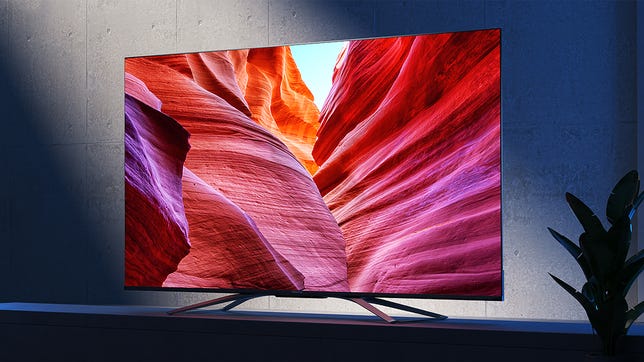

David Katzmaier/CNET
Most of the TVs on this list are bright enough for just about any room, but maybe you want a screen that’s as bright as possible. The U8G outshines others in its price range and was basically as bright as the significantly more expensive Samsung QN90A. Its image quality falls a bit short in other areas and its selection of sizes is limited, but if raw brightness is what you crave, the U8G delivers.
Sizes: 55-, 65-inch. (The prices shown below are for the 55-inch size.)
2022 outlook: The successor to the Hisense U8G is the U8H, shipping later this summer. The new version uses a mini-LED backlight and could improve the image quality of the 2021 model, but we haven’t reviewed it yet so we can’t say for sure. Unlike the 2021 U8G, the 2022 U8H includes an ATSC 3.0 tuner.

 \n ","topic":"TVs","ttag":"other","searchDim":"article-body|listicle|image","variant":"article-body|listicle|image","viewguid":"","event":"listicle|image|10","correlationId":"","assettitle":"","campaign":"other","cval":35,"leadCpc":0.35,"leadProdPrice":749.99,"manufacturer":"Samsung","productName":"Samsung Q60B Series (2022, 55-inch)","seriesGuid":"4792ec9d-3807-48e1-a50d-c53d59427edb","sku":"QN55Q60BAFXZA","reviewId":"","formatType":"IMAGE","location":"LIST","position":10,"dwLinkTag":"article-body|listicle|image","selector":"#article-body #listicle-671865a2-2277-4df1-8d76-3365e03d6097 .itemImage"}}” rel=”noopener nofollow” target=”_blank”>
\n ","topic":"TVs","ttag":"other","searchDim":"article-body|listicle|image","variant":"article-body|listicle|image","viewguid":"","event":"listicle|image|10","correlationId":"","assettitle":"","campaign":"other","cval":35,"leadCpc":0.35,"leadProdPrice":749.99,"manufacturer":"Samsung","productName":"Samsung Q60B Series (2022, 55-inch)","seriesGuid":"4792ec9d-3807-48e1-a50d-c53d59427edb","sku":"QN55Q60BAFXZA","reviewId":"","formatType":"IMAGE","location":"LIST","position":10,"dwLinkTag":"article-body|listicle|image","selector":"#article-body #listicle-671865a2-2277-4df1-8d76-3365e03d6097 .itemImage"}}” rel=”noopener nofollow” target=”_blank”>
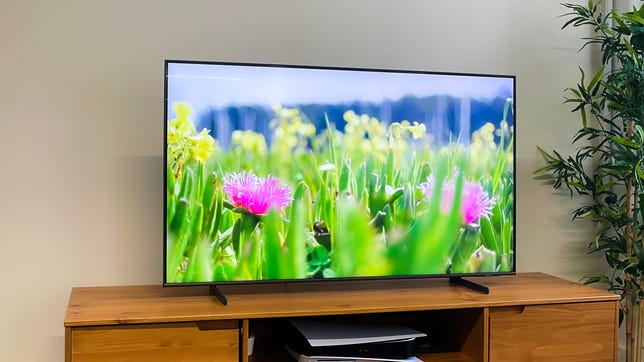

James Martin/CNET
Samsung is the brand that sells more TVs than anyone, and one of its most popular is the Q60 series. Its sleek QLED screen design stands out compared with the other TVs on this list — even though the ultrathin OLED models are sleeker — and it offers better features, image quality and more sizes than models like the TCL 4-Series and Sony X80K. The TVs listed in this article are all superior values, but if you want a Samsung TV and can’t afford the QN90A, this is a great choice.
Note that the 2021 version, the Q60A, is still on sale and can be cheaper than the Q60B in some sizes. The newer version measured brighter in our tests, but if you want the best deal, stick with the Q60A if it’s still available.
Sizes: 43-, 50-, 55-, 60- 65-, 70- 75-, 85-inch. (The prices shown below are for the 55-inch size.)
Other TVs we’ve tested
Sony KD-X80K series: Sony is a prominent brand and its higher-end TVs like the X90J do well in reviews, but the entry-level TV in its 2022 lineup, the X80K, didn’t make the list. It costs around the same as the TCL 6-Series and Samsung Q60 TVs, and had a worse picture than both, with lighter black levels and contrast. It’s definitely not a bad TV, and we liked its Google smart TV system, color accuracy and connectivity, but you can definitely do better for the money. Read our Sony KD-X80K series review.
Toshiba Amazon Fire TV C350 series: One of many Fire TVs available for sale, this one is typical of the breed: so-so image quality and a smart TV system that lags behind Roku and Google TV. If you’re a big fan of Alexa voice or see this TV at a really low price it might be worthwhile, but otherwise go for the TCL 4-Series. Read our Toshiba Amazon Fire TV C350 series review.
LG OLED G1 series: The G1 is an excellent overall TV, but compared to the C1 and C2, we don’t think it’s worth the extra money. Image quality is basically the same as those two models, so you just end up paying extra for its ultrathin, wall-hugging “gallery” design. On the other hand if that price difference is small enough — sometimes a G1 will cost only $100 more than a C1, for example — it might be worthwhile for you. Note that this TV’s successor, the 2022 LG G2, promises a brighter picture, but we haven’t reviewed it yet so we can’t say for sure. Read our LG OLED G1 series review.
How does CNET test TVs?
Our TV reviews follow a rigorous, unbiased evaluation process honed over nearly two decades of TV reviews. Our primary TV test lab has specialized equipment for measuring light and color, including a Konica Minolta CS-2000 spectroradiometer, a Murideo Sig-G 4K HDR signal generator and an AVPro Connect 8×8 4K HDR distribution matrix. We use Portrait Displays CalMan Ultimate software to evaluate every TV we review. In every CNET TV review, three or more similar TVs are compared side by side in various lighting conditions playing different media, including movies, TV shows and games, across a variety of test categories, from color to video processing to gaming to HDR. Our reviews also account for design, features, smart TV performance, HDMI input and gaming compatibility and other factors.
Read more: How We Test TVs
TV FAQs
We’ll post the answers to commonly asked TV questions below. If you have any others, feel free to reach out on Twitter (@dkatzmaier), or by clicking the little envelope icon on my CNET profile page. Doing so will let you send a message straight to my inbox.
How much should I spend on a TV?
Prices vary widely by size and features, from less than $100 for basic 24-inch TVs to more than $2,000 for big OLED models. TVs last a long time, however, so we think it’s worthwhile to spend a little extra beyond the bare minimum to get a bigger screen, better picture quality or better features. With that in mind, here’s some ballpark prices that will get you a very good TV in mid-2022.
- 55-inch: $700
- 66-inch: $1,000
- 75-inch: $1,300
You could pay (much) more or less. The fact is just about any TV will produce a picture decent enough to satisfy most viewers. Most complaints you read in user reviews aren’t about picture quality. Instead they’re about ease of use, smart TV menus or sound (or a broken TV).
What size TV should I buy?
In our opinion bigger is better, and your money is best spent on large screen sizes rather than a slight upgrade in image quality. The answer also depends on room size and seating distance: If you have a big room and sit farther away, you’ll want a bigger TV.
Which is better, OLED or LED?
In our reviews, OLED TVs, which use organic light-emitting diode technology, have always had better picture quality than LED TVs, which are basically LCD TVs that use LED backlights. The main reason is that OLED TVs can produce a perfectly dark shade of black with no stray illumination of blooming, which leads to better contrast and pop. LED TVs can get brighter, however, and usually cost less than OLED TVs.
What is the best smart TV system for streaming?
At CNET our favorite is Roku for its simplicity, but different systems like Google TV, Amazon Fire TV, Samsung and LG have different strengths, in particular for voice commands. In any case, we don’t consider the built-in smart TV system that important because you can always connect a streaming device to any TV.
How do I get the best TV sound?
Most TVs sound terrible, because their thin cabinets don’t have room for decent-size speakers or bass. If you want to get good sound you should buy an external audio system. Even an inexpensive soundbar will deliver much better audio quality than a TV’s built-in speakers.


